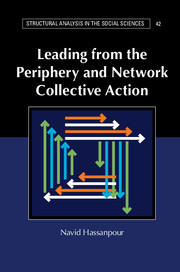Book contents
- Frontmatter
- Contents
- List of Figures
- List of Tables
- Acknowledgments
- 1 Mobilization from the Margins
- 2 Decentralization of Revolutionary Unrest: Dispersion Hypothesis
- 3 Vanguards at the Periphery: A Network Formulation
- 4 Civil War and Contagion in Small Worlds
- 5 Peripheral Influence: Experimentations in Collective Risk Taking
- 6 Decentralization and Power: Novel Modes of Social Organization
- 7 Appendix
- Bibliography
- Index
2 - Decentralization of Revolutionary Unrest: Dispersion Hypothesis
Published online by Cambridge University Press: 24 July 2017
- Frontmatter
- Contents
- List of Figures
- List of Tables
- Acknowledgments
- 1 Mobilization from the Margins
- 2 Decentralization of Revolutionary Unrest: Dispersion Hypothesis
- 3 Vanguards at the Periphery: A Network Formulation
- 4 Civil War and Contagion in Small Worlds
- 5 Peripheral Influence: Experimentations in Collective Risk Taking
- 6 Decentralization and Power: Novel Modes of Social Organization
- 7 Appendix
- Bibliography
- Index
Summary
… too many protests in too many places.
Peter Bouckaert, emergencies director of Human Rights Watch, Cairo, January 28, 2011Following three days of unrest and to counter the growing urban protests across Egypt, in the early hours of January 28 Mubarak's regime shut down the Internet and cell phone networks across the country. The surprising events of the next day suggest the incumbent's tactics were misguided. The protests in Cairo which were contained in Tahrir Square and surroundings up to that day, proliferated across the city and flared in every corner of Cairo. By 6 p.m. on January 28, the police forces were overwhelmed, and the military was called in to replace the police. In the following days a practically neutral military played a major role in the political developments of the country resulting in the ousting of Mubarak on February 11. The expansion of the protests on the 28th questions common wisdom on the role of social media in civil unrest, and the traditional logic of collective action. If an unlimited flow of information were to be indispensable to the escalation, then the disruption of the media across Egypt in the early morning hours of January 28th, should not have proliferated the unrest and exacerbated the decentralized nature of revolutionary contention.
In the following, using tens of mobilizational emails sent prior to the first day of unrest, I focus on the minute by minute developments on January 25, and contrast the dynamics of collective action on that day with those on the 28th. I argue that disrupting social and mobile media, contrary to Mubarak's intent, fostered more contention of a decentralized nature. An analysis of the singular dynamics of collective action in urban environments during blackouts reveals the distinct characteristics of leading from the periphery. It is as if in the absence of centralizing powers of far reaching communication, clandestine components of decentralized contention come to the fore.
Interestingly enough, disrupting media is a common characteristic of many revolutionary situations. Sometimes it is a byproduct of the paralyzing unrest; often it is the result of a governmental crackdown.
- Type
- Chapter
- Information
- Leading from the Periphery and Network Collective Action , pp. 27 - 68Publisher: Cambridge University PressPrint publication year: 2017

